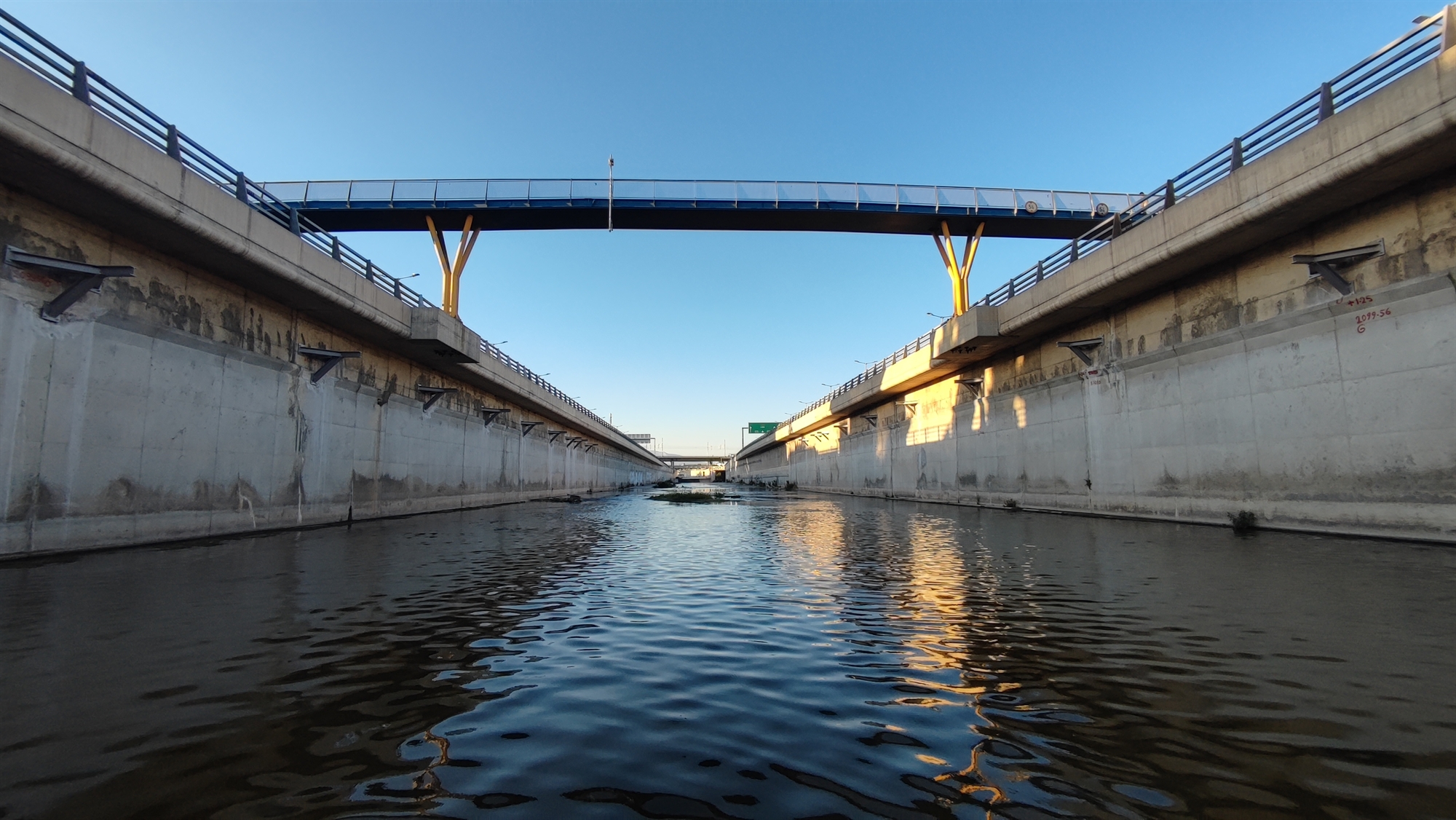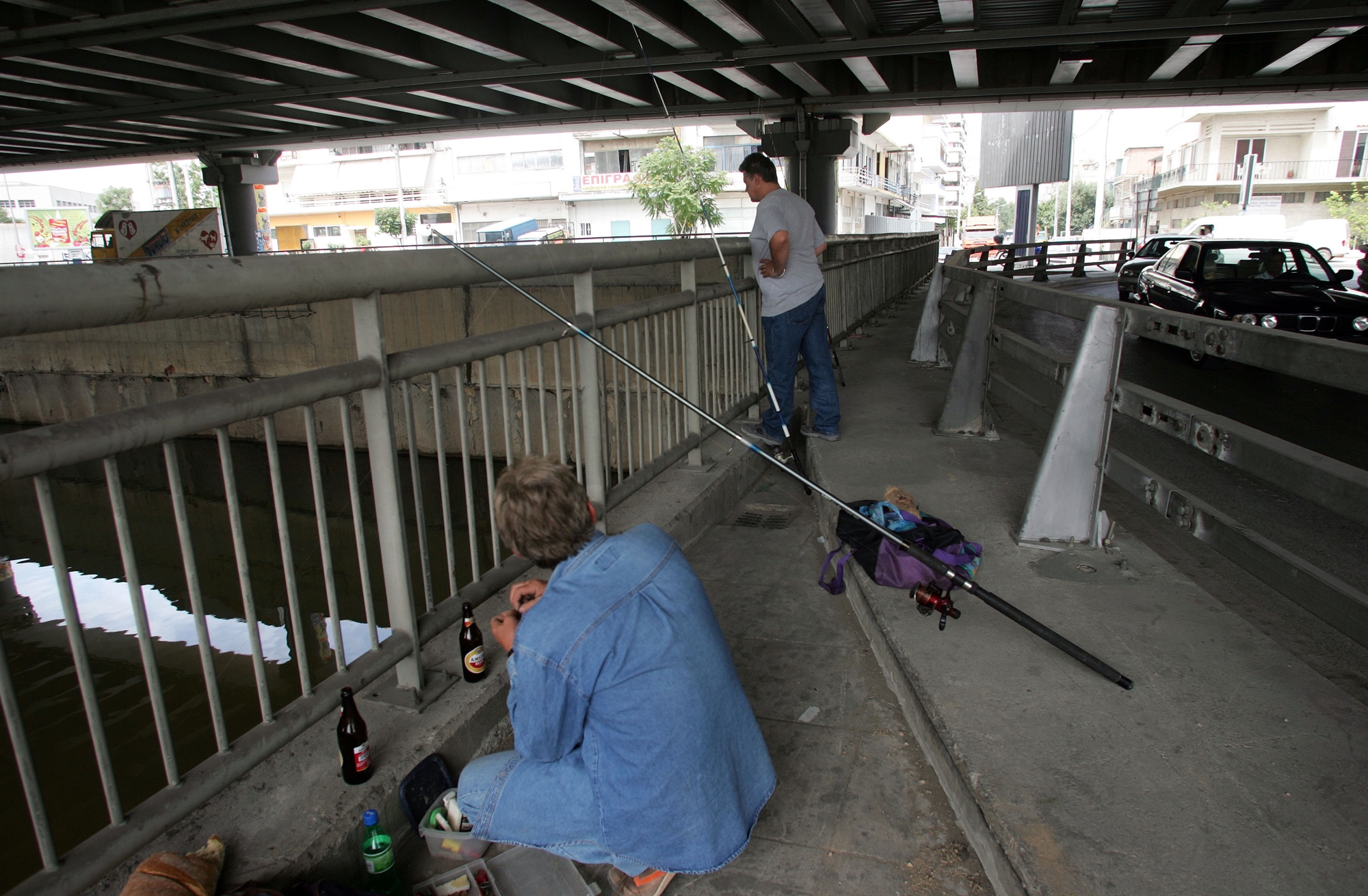
On the morning of Sunday, August 7, Dimitris Theodosopoulos and Giorgos Kafantaris descended with great care into the bed of Kifissos, low in the area of Rentis. The two men belong to Geomythics, an amateur group of cavers and engineers united by a common interest in exploration, which in recent years, among other things, has been excavating the closed and open streams of Attica.
The visit was not accidental. The stench in the area of Rentis and Moschatos, around the bed of the river Kifissos, was unbearable for several days. “A few days ago, neighbors turned to us and asked for help. We are residents of the area ourselves, so we decided to go and see what was going on,” says Mr. Theodosopoulos. They did not take long to wait: below the place where Kifisu Avenue again covers the river, perpendicular to its course, they found a large water conduit. “From the inside, sewer drains flowed into the bed. The stench was unbearable.”
It changes color
Last Monday, heavy rains in Attica brought Kifissos to life. A few hours later, at the mouth, in the bay of Faleri, the sea turned into a different color. But it was not only dirt and dust, as evidenced by large shiny spots in the sea, but also a strong stench that again engulfed the whole area. The same thing happens every time it rains, especially during the first autumn rains.
“It’s a shared secret of what’s going on,” Mr. Theodosopoulos explains. The “festival” comes from rooms high up in the bed of Kifissos. When it rains, they open their tanks, which contain everything from marble dust to chemicals, and pour them into the river. Depending on what they throw, Kifissos takes on a different color. In the lower sections, both in Kifissos and in other closed rivers, there are many illegal connections, small pipes from which drains from drains into oil or other drains.
However, illegal connections to the bed of Kifissos are not the only sources of pollution of the river. Since for the most part – along 14.1 km – Kifissos has become a waterway, closed or open, it also receives rainwater from some of the areas that it crosses. Various streams have also been diverted into it, such as the Podoniftis. So anyone who wants to “dispose” of anything, from the contents of a cesspool to any liquid waste, can simply “dump” it into one of the roadside pits. On rainy days, this will be hard to notice, as the rainwater will quickly remove the odor.
Recently, another illegal connection was discovered, from which sewage is dumped into the river. Dozens operate throughout it.
Crafts, industry
Thanasis Katsigiannis has been involved in environmental issues for many years. He was the first Chairman of the Parliamentary Environment Committee (established in 2005) and is today an authorized consultant for spatial planning and technical work in the Attica region. “In 1994, a decree for the protection of Kifissos defined zone A around its open channel and gave a 10-year time limit to relocate any businesses or crafts that operated there legally.
This relocation was not successful and the illegal activities around the riverbed were not stopped. Unfortunately, some people in the area still dump waste into the river.
In the part of Kifissos that is within the urban area, both stormwater and illegal connections enter, however, detection of illegal discharges is extremely difficult due to the conditions. That is why we intend to hire specialized people to check what is happening even in the closed parts of Kifissos.”
In addition to illegal sewage discharges in Kifissos, another source of stench, especially during the summer months, is the stagnant water in the last two kilometers of the channel before the sea, which is the result of poor design during the construction of dredging works. .
If no unforeseen circumstances are foreseen, from next year this problem will cease to exist: the regeneration projects of Faliriko Ormos include a project to clean the garden bed. This is a pipeline that will take water from the sea in the summer and discharge it through the pipeline into the bed of Kifissos, 2.3 km from its mouth. The construction of the facility is in full swing – a pumping station has already been built at the mouth of the river – and, according to regional services, it will be completed at the end of the year. This is perhaps the only one of Kifissos’ problems that seems to have a resolution horizon.

No personnel to check
Is Kifissos a river or a storm sewer? Although most of it has become a channel, Kifissos is still considered a river throughout, and not just in the upper part. However, its special position creates various problems, since it makes it difficult to control and intervene.
The quality status of Kifissos is monitored by the Ministry of the Environment. In Attica, the ELKETHE Department of Inland Waters and the State Directorate of General Chemistry are monitoring this, Petros Varelidis, Secretary General for Environment and Waters, explained: at three points in the middle and upper reaches of Kifissos and only one in the lower reaches. . “The lack of monitoring points downstream is due to the fact that most of the river is surrounded,” he says. There are no stations transmitting “real time” data for timely detection of a pollution event. “However, the Attica region is responsible for this issue,” explains Mr. Varelidis.
The region of Attica, which is responsible for the river, only performs an autopsy when there is a complaint about waste disposal.
The region interacts with Kifissos through its three departments: the department for the removal of transported materials from the bed and the departments for the environment and health for contamination cases. As in the case of the “find” of Geomitiki, the competent services of the region conducted an autopsy and sent the case to the prosecutor’s office. According to the Region, such inspections are usually carried out only after a complaint has been filed due to lack of staff.
“EYDAP has no authority in Kifissos,” says Kostas Vougiouklakis, general manager of the wastewater treatment company. “However, when there are complaints about illegal connections, EYDAP intervenes to shut them down and determine the source of origin. Over the years, we have identified many “mistakes”, recently we discovered a major pollutant in the Rentis area.”
Finally, the Ministry of Infrastructure is currently preparing a study to develop an open section from the Three Bridges to Attica Odos, a project that is getting a lot of feedback because it involves the destruction of a natural channel.

Many pollution sources show sampling and surveys
Monitoring of the ecological situation in Kifissos is fragmentary. Apart from sampling carried out periodically by ELKETHE and the State General Chemistry, there is no mechanism to immediately identify sources of pollution. However, the analysis shows what was expected: the ecological state of the river is poor, starting from the sections that touch the urban fabric.
“ELKETHE conducts sampling at two locations, Tatoi and Kyumi Avenue. The problem is that because the river is closed, access is limited, and therefore we do not have enough information about what happens before the mouth,” explains Ilias Dimitriou, research geologist at the Elkete Inland Waters Department. “Analysis of the water shows that Kifissos is in moderate to poor physical and chemical condition. Its biological status, as determined by inspection of benthic organisms, is usually moderate. Our results show that there are many sources of pollution, but a much more specialized approach is needed to identify sources.”
When it rains, Kifissos has more water than it should, based on the amount of rain.
microplastic
In addition to sewage, Kifissos also receives a large amount of garbage. A very recent publication by scientists from ELKETHE and EYDAP highlights the problem of microplastics in the river. Christina Zeri, ocean chemist and researcher at ELKETHE, led the scientific team. “In 2018 and 2019, we took samples and found a high concentration of microplastics, consistent with heavily loaded urban rivers in Europe,” says Ms. Zeri. “Kifissos has 18 microplastic particles per cubic meter of water, while Pinios has 1.8. After studying the qualitative characteristics of the particles, we saw that most of them are a plastic film, a material that resembles a plastic bag.”
The NTUA (School of Mining) Laboratory of Technical Geology and Hydrogeology has been researching Kifissos for the last 7 years. “Since 2016, we have installed 5 monitoring stations of this level,” says Andreas Kallioras, associate professor of the laboratory. “From our own research, we know that when it rains, Kifissos has more water than it should, based on the strength of the rain. Therefore, it accepts water of various origins: either drainpipes from different regions, or illegal discharge of liquid sewage.
The lab will open in November in collaboration with EYDAP, an EU-funded research program that will, for the first time, monitor the river quantitatively and qualitatively in real time. “However, it is puzzling that at a time when natural riverbeds are being restored around the world, in our country we are moving in the opposite direction,” says Mr. Kallioras. “In Los Angeles, which has a hydro-climatic similarity to Athens, a massive project is underway to restore the natural course of one-fifth of the river. In Attica, new products are being packaged all the time.”
Source: Kathimerini
James Springer is a renowned author and opinion writer, known for his bold and thought-provoking articles on a wide range of topics. He currently works as a writer at 247 news reel, where he uses his unique voice and sharp wit to offer fresh perspectives on current events. His articles are widely read and shared and has earned him a reputation as a talented and insightful writer.